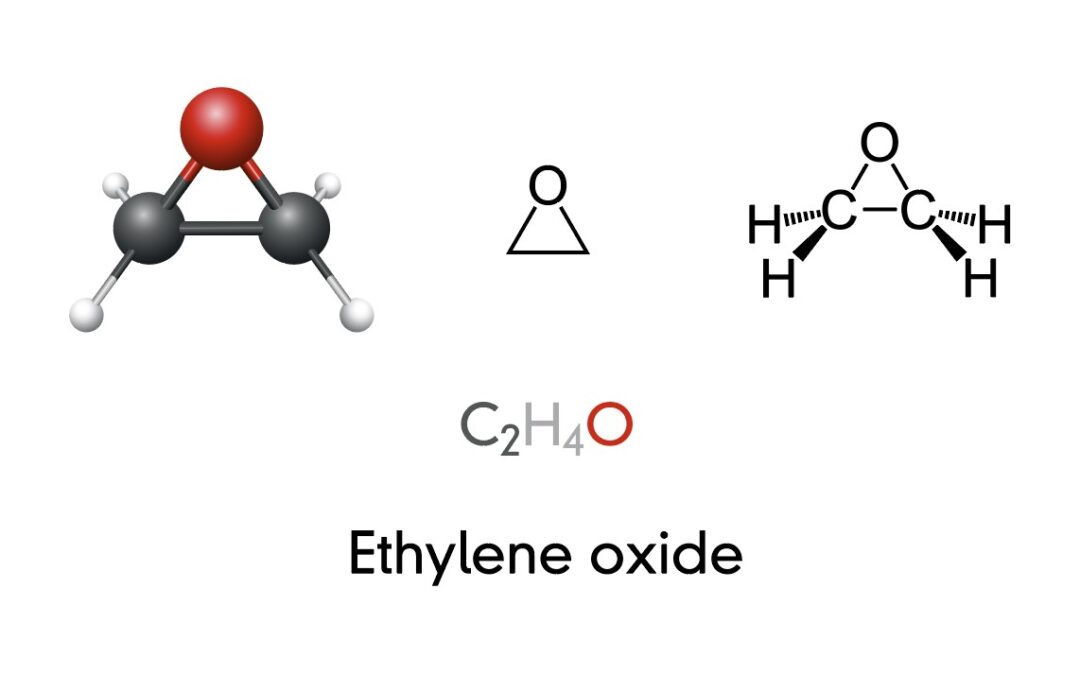Ethylene oxide is a potential silent killer present in your food and agriculture products and medical devices; therefore, it needs to be scaled down in your consumable items as per regulatory bodies. However, ethylene oxide is a manmade organic compound with a cyclic ether closed chain called Oxirane or Dimethylene oxide. It is a flammable gas, and it somewhat contains a sweet aroma. Industrially, ethylene oxide is produced by the oxidation of ethylene in the presence of a silver catalyst. Ethylene oxide is an intermediate industrial chemical used to produce ethylene glycol, which is further used to make antifreeze and polyester.
What are the sources of ETO in the environment?

A large amount of ETO is released through chemical industries, fumigation processes to control pests in buildings, food storage facilities, agricultural processes, medical surface sterilization, tailpipes, and tobacco smoke.
What are the uses of ETO?

ETO is one of the chemicals used to make a number of household items such as disinfectants, shampoos, laundry detergent, personal care items, fabrics, and textiles. It also had useful applications to control insects as well as surface sterilization for heat-tolerant medical devices and other agriculture and food products.
Why has ETO become a popular surface sterilization agent?

ETO treatment is effectively used due to its readily reacted nature and efficient sterilization at low temperatures for those medical devices with heat sensitivity, such as plastic, polythene, and other materials. It is effective against a wide range of microorganisms and can kill both bacteria and their spores. Spores are dormant, resistant forms of bacteria that can survive in harsh conditions and are more difficult to kill than their vegetative counterparts, for example, salmonella species. Some agricultural foods and their products are heat-sensitive and lose their nutrient values in the high-temperature sterilization process, that is why ETO is used.
How ethylene oxide becomes a silent killer

Ethylene oxide can be harmful to people by inhalation or skin contact. It is a highly reactive and dangerous gas that can irritate the eyes, nose, throat, and lungs. Long-term ethylene oxide exposure can lead to respiratory problems such bronchitis and asthma, as well as an increased risk of acquiring cancer, particularly leukaemia and lymphoma. Ethylene oxide, which is also a skin irritant, can produce chemical burns, blisters, and rashes. Furthermore, it may have a deleterious impact on reproductive health and foetal development if exposed during pregnancy.
It is vital to handle ethylene oxide with appropriate protections and safety measures to avoid detrimental effects on human health. Chronic exposure to ETO causes spontaneous abortion, sister chromatid exchange, and leukaemia.
However, due to the potential health hazards, the use of ethylene oxide in food production is closely restricted. If not handled appropriately, ethylene oxide is a hazardous gas that can cause respiratory problems, headaches, and other health concerns. As a result, food manufacturers must follow rigorous safety regulations to ensure that their products are safe for customers. Its residues are strictly monitored by national and international regulatory bodies.
What is the regulation for ETO residues in agriculture and its products?

A major incident came into the limelight with the detection of ethylene residues in sesame seeds exported from India to European countries (Belgium) during the year 2020, which resulted in a huge economic loss due to the recall of non-compliant food products. European regulation confined the maximum residue limit (MRL) to 0.05 milligrams per kilogram for sesame seeds. Therefore, it is a major concern for ETO residue testing in your food products.
However, regulatory bodies such as the Food and Drug Administration (FDA) in the United States and the European Food Safety Authority (EFSA) in the European Union have regulated the limit of ETO residue in food products and medical devices. To guarantee consumer safety, these organizations establish maximum residue limits (MRLs) for ETO in food and medical devices from time to time. ETO is considered a toxic gas and also a pesticide category due to its ability to kill viruses and bacteria, as per federal law in the US. While the European Union countries no longer considered the category of pesticide under Regulation (EC) 1107/2009.
The use of ethylene oxide as a pesticide or fumigant on food products is typically prohibited in the European Union. The European Commission has established maximum residue limits (MRLs) for ethylene oxide in food, which are typically in the parts per billion range. These MRLs are established with the goal of guaranteeing consumer safety while limiting exposure to potentially hazardous compounds.
What are the methods of ETO testing?

The most common instrument used for testing ETO is a gas chromatograph, which can detect the presence and quantity of ETO in a sample. Other instruments that may be used include mass spectrometers and infrared spectrometers. Fourier transform infrared (FTIR) spectroscopy involves measuring the absorption of infrared radiation by molecules in a sample to detect ETO.
How does Cultivator Phyto Lab keep your products safe?
Cultivator Phyto Lab is one of the state-of-the-art laboratories with cutting-edge technology in the north-western region of India to facilitate authentic ETO testing at a LOQ level of 0.01 mg/kg. We have a well-trained PT competency scientific group to perform ETO testing on Food and agricultural products, AYUSH, and herbal cosmetic products as per compliance with national and international regulatory bodies. Cultivator Phyto Lab has successfully developed GC-MS/MS and Headspace GC-MS/MS ETO identification and quantification testing procedures.
Authors: Dr. Sanjoy Gupta and Kumar Nitesh
References: –
- https://pubchem.ncbi.nlm.nih.gov/compound/Ethylene-oxide
- https://en.wikipedia.org/wiki/Ethylene_oxide
- https://pubmed.ncbi.nlm.nih.gov/2954522/
- https://food.ec.europa.eu/system/files/2021-01/rasff_ethylene-oxide-incident_crisis-coord_sum.pdf
- https://www.regulations.gov/document/EPA-HQ-OPP-2013-0244-0023
- http://www.indianspices.com/sites/default/files/EU%20CIRCULAR%20ETO%20AND%20ANNEX%20I_compressed-2.pdf
- https://www.ncbi.nlm.nih.gov/pmc/articles/PMC5226145/pdf/nihms826134.pdf

